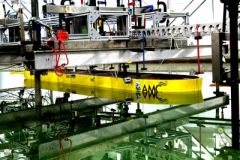A researcher at AMC is creating waves that will help the largest vessels ever constructed extract and process natural gas in tough offshore conditions.
Floating Liquified Natural Gas (FLNG) is a new method that will enable natural gas to be extracted from previously inaccessible locations, using gigantic floating facilities to allow the entire process of extraction, processing and storage to take place offshore.
This requires the construction of the largest offshore facilities ever known: the world’s first FLNG platform, Prelude, is expected to arrive 475km off the coast of Western Australia next year and will be longer than four soccer pitches.
But in order to exploit the opportunities offered by the technology, FLNG platforms must be able to withstand hostile weather conditions—such as tropical cyclones—that are commonly found so far offshore, whilst maintaining operations, including offloading the liquefied gas onto much smaller tankers for delivery to market, with as little disruption as possible.
Because platforms of this size have not been observed in a real world environment before, PhD student Yuting Jin is simulating waves in a pool and on a computer to understand the way the vessels will behave and to be able to make recommendations that will help them undertake their high-risk work safely in remote, challenging conditions.
Helping realise the potential of the new technology is something that motivates Yuting for reasons beyond his own research ambitions.
“Natural gas is the cleanest fossil fuel and with FLNG there will be no need for on-shore processing plants in Australia, minimizing the damage to the environment,” Yuting said.
Yuting first deployed a 1:100 scale model of Prelude in AMC’s 100 meter long towing tank—one of just a handful of such facilities globally—before generating waves using a machine.
He then compared the results to those produced by numerical modelling using Computational Fluid Dynamics (CFD), which uses applied mathematics, physics and computational software to visualize how a liquid flows and how it affects objects it passes.
Yuting turned to an increasingly popular CFD method called Unsteady RANS, which relies on serious computing power to include in its calculations the effect of viscosity—comparable to the ‘thickness’—of the water. Being able to factor in viscosity is critical for making accurate predictions as it causes friction on the hulls of the vessels that can affect how the waves form.
The specific problem Yuting is investigating is called hydrodynamic interaction; or how the motion of the platform is affected when another vessel is present – in this case, when the much smaller tankers moor up alongside the platform for the gas to be unloaded. The waves that form can cause the platform to pitch and roll, potentially threatening safe operations.
“There are many examples that are similar in concept to hydrodynamic interaction in our everyday lives; for example, people are asked to stand back from the edge of the platform at a railway station because when a high-speed train passes it creates a strong suction force that can be hazardous.”
To date, Yuting has simulated the interaction between the FLNG platform and the tankers that the gas is offload onto, as well as analysed how the motion of the platform is affected by both bow to stern and oblique currents.
He continues to simulate the FLNG vessels in different conditions and plans to produce a set of operational and training recommendations, as well as to identify whether regulations are needed for these gigantic platforms to carry out their work safely.
His research continues until 2018 but he hopes his work will make a small contribution to the world’s power demands for generations to come.
“The richness of both traditional and renewable energy resources in the ocean inspires me to contribute to our ability to harness them for the benefit of future societies.”
Published on: 26 Aug 2016

